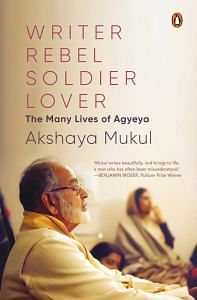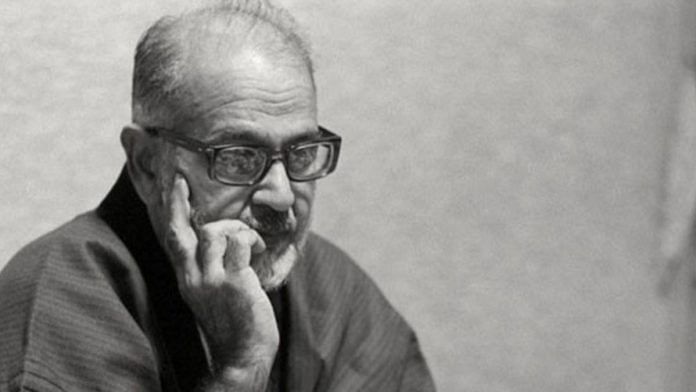For much of 1949, Agyeya was occupied with a hagiographic volume planned for Nehru’s sixtieth birthday in November that year. The Nehru Abhinandan Granth: A Birthday Book was commissioned by Viswanath More of Arayavrata Prakashan Griha, Calcutta. Its editorial office was run out of Prabhudayal Building in Connaught Circus, Delhi.
A formidable editorial board, dominated largely by Nehru’s political adversaries, was created. On the board, Agyeya was in the company of Rajendra Prasad, Purushottam Das Tandon, S. Radhakrishnan, K.M. Munshi, Seth Govind Das, Vishwanath More, Nandalal Bose and Lanka Sundaram. The youngest member, Agyeya, seems to have done most of the work. He was also a member of the book’s management committee.
Agyeya’s correspondence with a vast network of potential contributors provides a glimpse into the intellectual and political scene of the time as well as his own priorities and preferences in these spheres. The Nehru Abhinandan Granth was a lavish initiative, produced in line with top international standards, with two separate volumes in English and Hindi planned. Each volume would have four sections. A biography section, written by ICS officer and art connoisseur N.C. Mehta, detailed Nehru’s life and role in the national movement. There was a separate section for anecdotes, which had an interesting mix of reminiscences from a diverse set of people. The third section had articles on a subject of the writer’s choice, and the last section included literary works in different languages, written specially for the volume.
When Agyeya and Lanka Sundaram had a difference of opinion on the arrangement of contributions in the last two sections, Seth Govind Das intervened. Agyeya was asked to concentrate on the Hindi edition and Sundaram on the English. Other members of the editorial board commissioned articles directly related to Nehru—including by writers like Will Durant, Harold J. Laski, Edmond Privat, André Gide, Stephen Spender, Edgar Snow, Muriel Lester and Fenner Brockway.
Agyeya was busy with commissioning essays, stories and reminiscences for the rest of the collection. One of the first people he reached out to was his army friend Sydney Bolt. Before being enlisted and posted in India, Bolt was a student at Trinity College, Cambridge, and a key member of the university’s communist movement along with Eric Hobsbawm and John Maynard Smith. After the war, he worked briefly in private companies in India and a shipping company in Pakistan before rejoining academics as head of English at Cambridgeshire College of Arts and Technology, and later as supervisor in English at Corpus Christi College, Cambridge.
Agyeya asked Sydney to help him with a copy of International Authors and Writers Who’s Who and also send copies of E.M. Forster’s Challenger of Our Time, T.S. Eliot’s Notes Towards the Definition of Culture and a commemoration volume on George Bernard Shaw. A few of the foreigners Agyeya approached declined. Writer W. Somerset Maugham said his ‘acquaintance’ with Nehru was ‘slight’, dating back only ten years. He felt it would be the ‘height of indiscretion’ on his part to write about his life. German–English writer Robert Neumann too felt his knowledge of Nehru was highly ‘unoriginal and incomplete’. Irish short-story writer Sean O’Faolain said he had writer’s block, but sent a story he had written for the New Statesman. The most lyrical letter of regret came from Nobel laureate André Gide. From a hospital in Nice, he wrote in French: ‘Condemned to almost absolute rest during a long convalescence, and moreover incapable of effort, I particularly regret not being able to pay my tribute to the stately demeanour of Nehru.’
But English soldier, historian and socialist politician Tom Wintringham wrote of Nehru’s Glimpses of World History that, in the future, if Indian children learnt English, they should ‘insist they are taught from the Glimpses rather than from Macaulay or [Edward] Gibbon’.
Also read: ‘Plane broke into three pieces’: Hardit Singh’s first flight over German lines in Droglandt
Agyeya approached academics in India too. Anthropologist Verrier Elwin wrote an essay on ancient and modern man in India.
Historian Raghubir Sinh, the heir apparent of Sitamau in Malwa, readily agreed to write on Bapu Vithal Mahadev, the Maharashtrian diplomat who had been Daulat Rao Scindia’s chief minister. Two historians from Bengal contributed articles: Jadunath Sarkar wrote on Kashmir under Muslim rule, while R.C. Majumdar wrote about India’s martial races. Agyeya consulted the Gandhian Viyogi Hari, of the All India Harijan Sevak Sangh, about other contributors. From his suggestions, Rai Krishna Das and Ramdhari Singh Dinkar were included in the volume. It seems writer politician Sampurnanand was shortlisted by Agyeya, but there was nothing from him in either the English or Hindi volumes despite three reminders. Others declined. An essay titled ‘Intellect, Faith and Action’ by Kishorlal G.
Mashruwala, the editor of Harijan, almost did not make it to publication. Its author tore up the first draft, but his wife retrieved it from the garbage can. Eventually Mashruwala sent two drafts, which Agyeya edited with his permission. Agyeya also tried to get a contribution from the peasant leader Swami Sahajanand, whom he got to know while working with farmers in Meerut. A trenchant critic of the Congress, Sahajanand agreed, with caveats. Agyeya wanted him to write anecdotes without judgement, so that ‘people of different belief systems can write about their experience of Nehru. Thus a complete picture of Panditji would emerge. Direct criticism might not help.’ Nuance was not Sahajanand’s forte, and ultimately, he did not contribute.
Agyeya even reached out to Banarsi Das Chaturvedi who, unsurprisingly, declined. ‘It would have been better if a volume was planned on the martyrs. For the past 18 years Chandrasekhar Azad’s mother is dying of hunger. I am no one to advise you. Please do what you feel is right,’ he wrote. Agyeya responded mildly—he no longer relied on Chaturvedi’s approval. Some writers declined tactfully—Visva-Bharati vice chancellor Rathindranath Tagore (Rabindranath’s son) expressed his inability to do ‘proper justice to the subject’, and Hindi prose stylist Shivpujan Sahay was busy with a similar commemoration volume on Rajendra Prasad. Others, like Rajani Palme Dutt of the Communist Party of Great Britain, expressed outrage at even being approached. Dutt found himself ‘at present in very sharp disagreement with the policies now being pursued by Pandit Nehru’. In a book of tributes, he did not want to write what would ‘inevitably be of a sharply critical character’.
Also read: ‘Shut up! Damn you! Go to hell’ – Ashok Kumar, the heartthrob who struggled with fame
M.N. Roy too was reluctant to praise Nehru, but asked Agyeya whether there would be remuneration for a potential contribution. Agyeya honestly replied that he had a feeling the project would fail because of its high price and the ‘considerable general disillusionment and perplexity’ around it. But there was an honorarium for special cases, so he asked Roy to send a formal pitch to him with his fee. Roy eventually wrote an article on humanism for the book. When Roy asked Agyeya to contribute to his own journal, Independent India (later Radical Humanist), the latter said he was ‘overworked’, dragged down by ‘routine work on the brink of exhaustion from day to day without a job and with gradually mounting disapprobation from Right & Left’. He also revealed that, financially, it was a tough time as Pratik was losing money; each issue cost Rs 800. He had also somehow ‘fortuitously acquired a refugee family— an invalid, his wife and two sons’ who went to school. ‘Even a relatively fast selling author finds it difficult,’ he told Roy.
Roy wrote back with concern. ‘I am afraid you keep too much to yourself, and even inside yourself. That often puts one in blues. You ought to be less esoteric. I am also sort of a recluse. But once in a year I go out in the wide world. There are some people worth the trouble. But let me not sermonise.’ Roy invited Agyeya to the summer 1949 camp of the Radical Democratic Party in Mussoorie, which would be attended, he said, by Eric P.W. da Costa, the editor of Eastern Economist and later one of India’s finest psephologists.
While work for the Nehru volume was ongoing, Agyeya took up the invitation.He wrote to Ellen Roy that perhaps he should not be running away from Allahabad: ‘More decisions are made for me by things outside myself than I like to admit.’ He enjoyed the break, and returned to monsoon in Allahabad with two kittens he had picked up from the Roys’ Dehradun residence. The house on Hastings Road proved an excellent playground for Tamas, the black kitten, and Ira, whose name stood for the Indian Renaissance Association, despite its poetic connotations. Agyeya discovered they had ‘fancy tastes and a special liking for fountain pens’.

This excerpt from ‘Writer, Rebel, Soldier, Lover: The Many Lives of Agyeya’ by Akshaya Mukul has been published with permission from Penguin Random House India.



